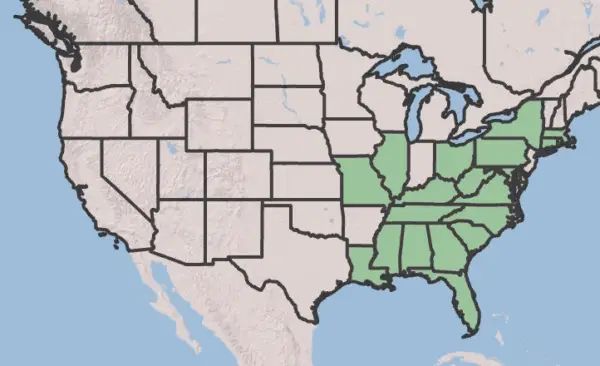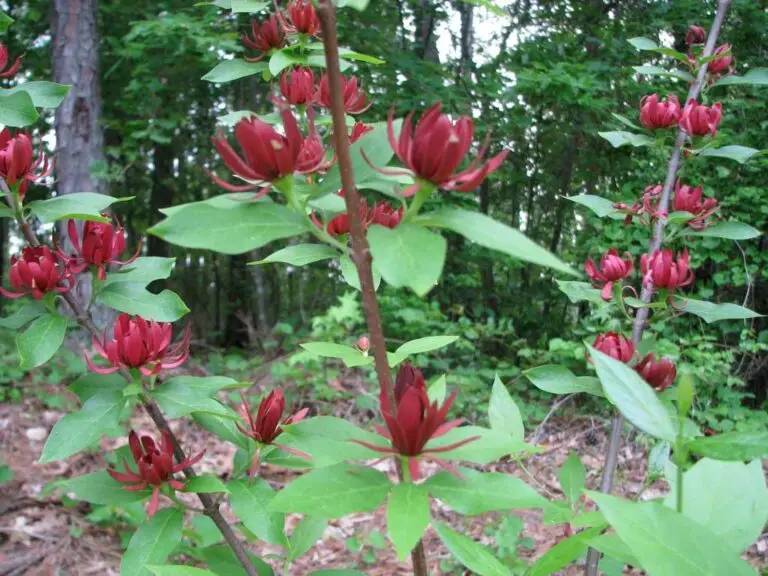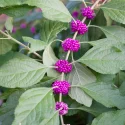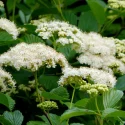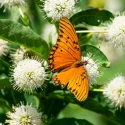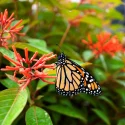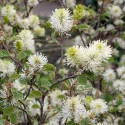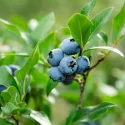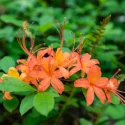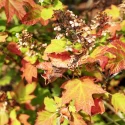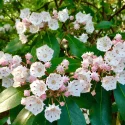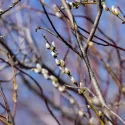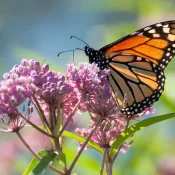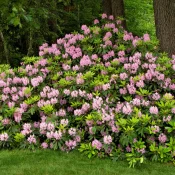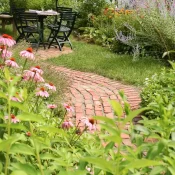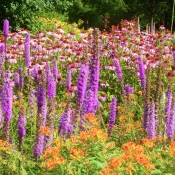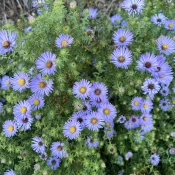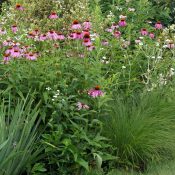Sweetshrub
Sweetshrubs are native bushes known for their distinctive dark-red flowers that often smell heavenly (hence the name.) The smell is sometimes described as pineapple, strawberry, melon, or bubble gum. They prefer part-sun and are native to a wide range of the East Coast. Sweetshrubs are perfect for the edges of yards or hedgerows. These fast-growing shrubs can turn into small trees, growing to 12 feet tall when happy. Regardless of the candy flavor you associate their smell with, plant Sweetshrub immediately. Scroll on for planting tips.
- Full Sun, Part Sun
- Tall Shrub (11-15')
- Early summer flowers
- Pollinator lifeline
Sweetshrubs are wonderful native plants that deserve a place in Northeastern, Southern, and Mid-Atlantic gardens. Planting native shrubs like Sweetshrub helps make yards and parks gorgeous (and sweet-smelling!) and saves time, money, and care—especially when compared to lawns or non-native plants. In this article, we’ll talk about its namesake smell, share ideas on where to plant, and end with some sourcing ideas.
Let’s dig in by starting with its name.
Sweetshrub is named for its glorious smell
This plant has many common names, each an attempt to pay homage to its smell: Carolina allspice, sweet bubby, sweet Betsy, Carolina Sweetshrub, or Strawberry Bush (its Latin name is Calycanthus floridus.)
How do you describe the Sweetshrub scent?
There is no consensus on how to describe the smell—the descriptions range from strawberry to banana. We love this quote from Horticulture Magazine:
“If you’re in for a good time, fill a room with plant dweebs and ask each to describe the fragrance of C. floridus flowers. All will agree that it varies quite a bit from one plant to the next, from flower to flower on one plant and from morning until evening. But that’s about where the consensus ends. The scent is strawberry, green apple—I even had one group of University of Maine woody-plant students concur that it smelled like that crunchy white paste used (still?) by kindergarteners across the land. Bruised bark and roots smell of camphor or, by that same class of college students, gin and tonic.”
This plant can smell like multiple aisles of the grocery store!
If its smell inspires you, we have a tip:
Not all native Sweetshrubs have a strong scent
While all Sweetshrubs have beautiful flowers, not all native Sweetshrubs have a sweet fragrance. The smell can vary from plant to plant.
If you are looking for a candy-smelling Sweetshrub, take a cutting from a Sweetshrub that has the smell, or buy plants from a local native nursery or plant society sale that can attest to their fragrance. Otherwise, you may end up with a Sweetshrub that looks fantastic but might not live up to the ‘Strawberry bush’ common name.
Sadly, the Sweetshrubs I planted in my yard are non-scented. But they are absolutely beautiful and have grown 15′ high in just a few years while being entirely neglected (after they were established in the first year, I’ve yet to water them—even during drought periods).
If you want a scented Sweetshrub, you can also consider a cultivar
Cultivar is a name that comes from CULTivated VARiety, or a plant that has been curated or changed in some way by humans. (Here is a quick cultivar overview.)
A few Sweetshrub cultivars have been cultivated to offer good-smelling flowers:
- Sweetshrub ‘Michael Lindsey’ is commonly called the best of the cultivars, based on its lovely smell and easy-to-plant nature
- Sweetshrub ‘Venus’ has wonderful white flowers
- Sweetshrub ‘Aphrodite’ doesn’t grow as tall as its native counterpart (5-8′ on average)
Cultivar plants offer a wide range of smells, colors, heights, and drought tolerance but often do not provide the same nutrients and benefits that true native plants do. Which is why, The Plant Native has a recommendation.
Native vs. Cultivar
Plant true native plants whenever possible. Cultivars (short for CULTivated VARieties) are selected by humans and often do not offer the same benefits to bugs, birds, and animals that native plants do.
Sweetshrubs through the seasons
Sweetshrubs offer four seasons of beauty—it’s not just about the flowers!
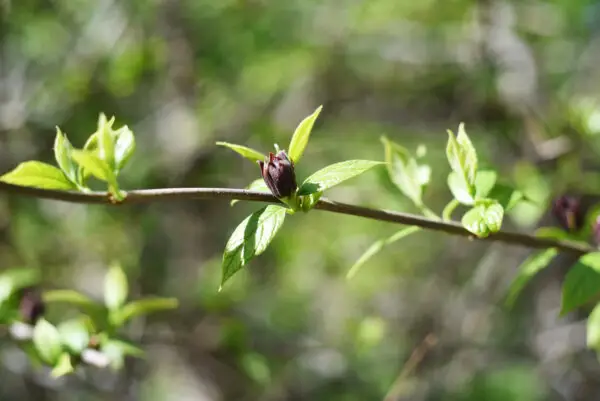
In spring, buds appear snuggled against the branches. Glossy, dark green leaves begin to take center stage as spring progresses, creating a lush and vibrant backdrop for the flowers.
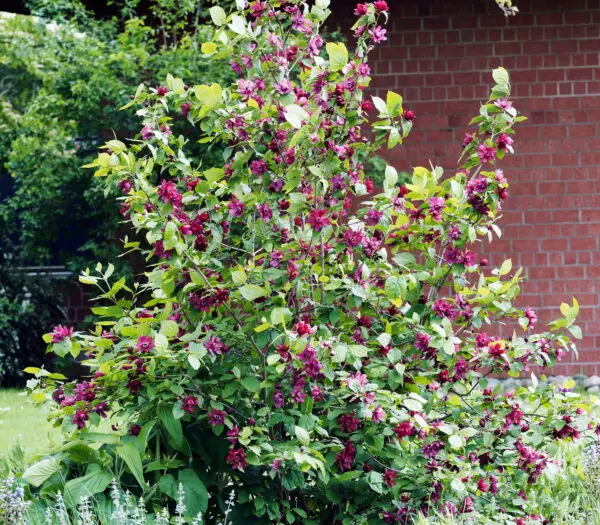
When spring starts to wrap up and summer arrives, the Sweetshrub flowers bloom. The color is singular—very few plants have flowers in such a deep maroon hue (check out Pawpaws if you like this maroon flower color.)
The shrub is a fast grower, too. Expect branches to elongate throughout the growing season.
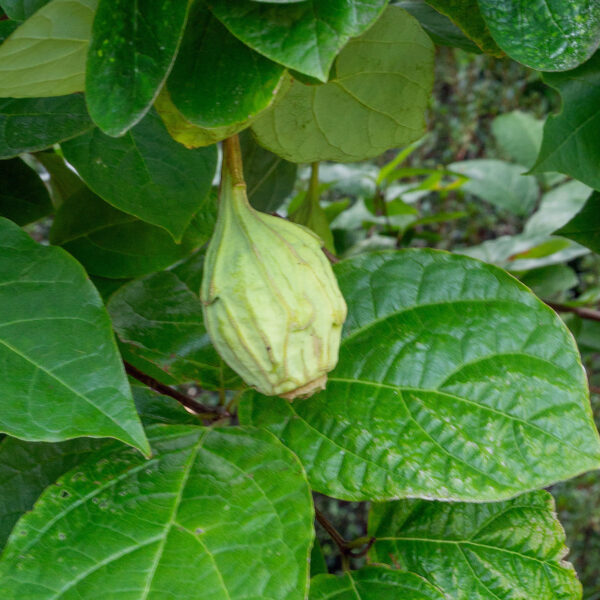
As fall begins, look out for any pollinated flowers to turn into Sweetshrub fruits. These strange-looking green fruits hang down and can persist into the winter. Crack one open after they’ve ripened to find several glossy seeds within.
As fall continues on, the Sweetshrub steals the show once again. Its green leaves transform into rich yellows, burnt oranges, and deep reds, adding a fiery touch to the seasonal leaf party.
Even as winter settles in, this resilient shrub refuses to go unnoticed. The interesting seed pods, resembling small, woody capsules, look like tiny fairy houses hanging from the branches.
And then it’s time to start the show all over again!
Where is Sweetshrub native?
Sweetshrub is native to a wide portion of the Northeastern, Mid-Atlantic, and Southern US, from Massachusetts to Florida.
How to grow Sweetshrub
When in nature, sweetshrubs are understory shrubs or plants that like to grow underneath larger trees. Because of this, they appreciate some shade, especially during the hottest parts of the day. While Sweetshrubs are generally low-maintenance, occasional pruning after they flower will help maintain their shape and encourage optimal growth.
Where to find a Sweetshrub for your yard
Wondering where to find this native gem? The reality is that finding native plants can sometimes be difficult. But it’s easy to find natives, if you know where to look!
Here are some recommendations for finding Sweetshrubs:
Where can I find seeds and plants?
Finding native plants can be challenging (we partly blame Marie Antoinette.) To make it easier, we’ve assembled four sourcing ideas.
Native Nursery List
300+ native nurseries makes finding one a breeze
Online Native Plant Sellers
We've included 100+ online resources to help
Society Plant Sales
Every state has a native plant society; find yours
Online Communities
Local Facebook groups are a great plant source
What to plant with Sweetshrub
Sweetshrub looks wonderful with part-shade shorter native plants underneath, like Alum Root/ heuchera, Red Columbine, and Foamflower. It also looks amazing planted alongside other native shrubs that offer other seasonal showstoppers, like Winterberry and Ninebark. If you’re looking for a tree to plant beside it, check out Tulip Populars, Sweetbay Magnolias, and Redbuds.
To wrap things up, the Sweetshrub is a native shrub that belongs in gardens in the Northeast, Mid-Atlantic, Midwest, and South. Its beauty changes throughout the seasons, with origami candy flowers in the spring, lush foliage in summer, stunning colors in autumn, and intriguing seed pods in winter. Native plants like the Sweetshrub give us beautiful landscapes with less work, time, and money—especially compared to lawns. So, why not plant a few? Happy planting!
Sources
- Clemson State Extension, Sweetshrub
- Nelson, Gil. Best Native Plants for Southern Gardens. (2010), 86-87.
- USDA, Sweetshrub
